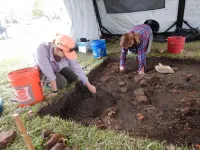(Press-News.org) DURHAM, N.C. - People who have a gene variant associated with an increased risk of developing Alzheimer's disease also tend to have changes in the fluid around their brain and spinal cord that are detectable years before symptoms arise, according to new research from Duke Health.
The work found that in people who carry the APOE4 gene variant, which is found in roughly 25 percent of the population, the cerebrospinal fluid contains lower levels of certain inflammatory molecules. This raises the possibility that these inflammatory molecules may be collecting in the brain where they may be damaging synapses, rather than floating freely in the cerebrospinal fluid.
The findings, which were published online last month in the Journal of Alzheimer's Disease, provide a potential means to identify the earliest mechanisms occurring among APOE4 carriers that might contribute to Alzheimer's disease before people develop memory problems or other symptoms of dementia.
"Our work suggests a potential role for a long-studied molecule called C-reactive protein (CRP), which is typically elevated when there's inflammation, as a factor in the increased Alzheimer's disease risk seen in APOE4 carriers," said lead author Miles Berger, M.D., Ph.D., associate professor in Duke's Department of Anesthesiology.
Berger and colleagues analyzed data from targeted cerebrospinal fluid of Alzheimer's Disease Neuroimaging Institute research participants. Controlling for Alzheimer's disease clinical status, they identified protein level variations in the cerebrospinal fluid from people with an increasing number of APOE4 gene variant copies. They found that people with more APOE4 copies had lower CRP levels circulating in their cerebrospinal fluid.
Berger said this is consistent with the current risk profile associated with APOE4 carriers. People with a single APOE4 variant have about a three- to four-fold increased risk of developing Alzheimer's disease, while those who carry two APOE4 variants have a greater than 10-fold risk.
"We found that spinal fluid CRP levels are lower in people with the APOE4 allele, before they ever develop dementia or even mild cognitive impairment," Berger said. "This suggests that CRP might be actively involved in damaging synapses. We think CRP is doing this together with a cascade of inflammatory proteins called complement, which sequentially activate each other like a row of dominos falling.
"Altered complement activity has also been found at autopsy in the brains of patients who suffered from Alzheimer's disease, and the complement pathway can both damage synapses and target them for destruction," Berger said. "Our results raise the possibility that processes like these operating over many years and even decades in APOE4 carriers could eventually result in Alzheimer's disease pathology and cognitive decline."
Berger said there are other inflammatory diseases for which CRP can be decreased rather than elevated, notably lupus. He said therapies used to control CRP for conditions such as rheumatoid arthritis and vasculitis might warrant investigation for Alzheimer's disease, but additional studies are needed to further illuminate the Duke team's findings.
"Maybe those with more APOE4 variants have excessive deletion of synapses throughout life, until it gets to point where brain can't process information anymore," Berger said. "It would be like taking a book and randomly deleting every 1000th letter. For a while, you could do that and the book would still make sense. But after time, too many letters would be gone and you would lose the information in the book. We think that might be what's happening in the brain."
INFORMATION:
In addition to Berger, study authors include Mary Cooter, Alexander S. Roesler, Stacey Chung, John Park, Jennifer L. Modliszewski, Keith W. VanDusen, J. Will Thompson, Arthur Moseley, Michael J. Devinney, Shayan Smani, Ashley Hall, Victor Cai, Jeffrey N. Browndyke, Michael W. Lutz, David L. Corcoran and Alzheimer's Disease Neuroimaging Initiative.
The study received support from the National Institutes of Health (P30AG028716, UH2AG056925, U01 AG024904) the Alzheimer's Drug Discovery Foundation, the inaugural Ann Bussel award from the Ruth K. Broad Foundation at Duke University, and the Duke Anesthesiology Department. A full listing of supportive funding is provided in the study.
A team of researchers from Russia and Israel applied a new algorithm to classify the severity of autistic personality traits by studying subjects' brain activity.
The article 'Brief Report: Classification of Autistic Traits According to Brain Activity Recoded by fNIRS Using ε-Complexity Coefficients' is published in the Journal of Autism and Developmental Disorders.
When diagnosing autism and other mental disorders, physicians increasingly use neuroimaging methods in addition to traditional testing and observation. Such diagnostic methods are not only ...
Using a dataset on daily patrols and enforcement activities of officers in the Chicago Police Department (CPD) - an agency that has undergone substantial diversification in recent decades - researchers report Black officers used force less often than white officers during the three-year period studied, and women used force less often than men. These and other findings provide insight into impacts of diversification in policing, a widely proposed policing reform. "The magnitude of the differences [here] provides strong evidence that--at least in some cities--the number of officers who identify with vulnerable groups can matter quite a bit in predicting police behavior," writes Philip Goff in a related Perspective. Racial disparities in police-civilian interactions ...
Fin whale song - one of the strongest animal calls in the ocean - can be used as a seismic source for probing the structure of Earth's crust at the seafloor, researchers report. While the novel method produces lower-resolution results compared to the high-energy air-gun signals commonly used in seismic ocean surveys, the abundant and globally available fin whale calls could complement and enhance seismic studies where conventional techniques cannot be used. Surveying the structure of the ocean crust often requires powerful seismic waves. This is most commonly done using ship-based ...
During the Proterozoic, Earth grew no taller - the tectonic processes that form mountains stalled, leaving continents devoid of high mountains for nearly 1 billion years, according to a new study. Because mountain formation is crucial to nutrient cycling, the prolonged shift in crustal activity may have resulted in the "boring billion," an eon in which the evolution of Earth's life stalled. Over geologic timescales, even mountains are ephemeral. The massive tectonic forces that drive vast swaths of the planet skywards are countered by the interminable processes of erosion. Because the thickness of Earth's crust is in constant flux, tracking mountain formation over deep time is challenging, yet crucial to understanding the evolution of the planet's surface and the life that lives upon it. ...
Building modern human brain organoids with the Neanderthal variant of a gene has provided a glimpse into the way substitutions in this gene impacted our species' evolution. The ability to grow brain organoids with specific archaic genes provides a way to identify and evaluate the functional differences between the closely related genomes of hominin lineages and explore the evolutionary changes that underly the unique traits that set us as modern humans apart from our extinct relatives. While the genomes of modern humans and their archaic Neanderthal and Denisovan relatives are, in many respects, similar, the genetic differences between ...
Previous studies have shown people can identify the gender and race of a speaker based on the words chosen, but could a person identify something like political membership? A team of researchers at Carnegie Mellon University found people are more successful at identifying language associated with Republican speech than Democratic speech patterns. The results are available in the February issue of the journal PLOS.
"While other studies have shown that people can detect social categories like the race and gender of a speaker based word choice, ...
A nationwide analysis of data from the first 6 months of the COVID-19 pandemic in Argentina has identified factors associated with increased risk of death or admission to an intensive care unit (ICU) due to the disease, including older age, male sex, coma, seizures, and underlying comorbidities. Daniel Schoenfeld of Centro Diagnostico San Jorge in Puerto Madryn, Argentina, and colleagues present these findings in the open-access journal PLOS ONE on February 11.
Argentina reported its first case of COVID-19 on March 3, 2020, and a national lockdown ...
Delirium, a form of acute brain dysfunction, is widespread in critically ill patients in lower resourced hospitals, and the duration of delirium predicted both mortality and disability at six months after discharge, according to a study published in PLOS ONE.
Working with partners in Zambia, Vanderbilt University Medical Center researchers evaluated 711 hospitalized critically ill patients; delirium occurred in 48.5%. The findings shed light on the impact of delirium on a patient's recovery -- and even whether a patient is likely to live or die.
There have been limited data on the prevalence and outcomes of delirium ...
Women today represent two-thirds of all Canadian doctorates in archaeology, but only one-third of Canadian tenure-stream faculty. While men with Canadian PhDs have done well in securing tenure-track jobs in Canada over the past 15 years, women have not, according to a new study from McGill University. The current COVID-19 pandemic is likely to exacerbate these existing inequalities.
Published in American Antiquity, the study is the first to follow archaeologists from graduate school to faculty positions to determine when women are exiting the academic track. It's also the first to explore grant applications and the success rates of women in Canadian archaeology.
"A 'chilly climate' exists for women in academia. ...
PROVIDENCE, R.I. [Brown University] -- One thing that decades of social science research has made abundantly clear? Americans in urban areas live in neighborhoods deeply segregated by race -- and they always have.
Less clear, however, is whether city-dwellers stay segregated when they leave home and go about their daily routines. That's a question to which Jennifer Candipan, an assistant professor of sociology at Brown University, was determined to find an answer.
By analyzing geotagged locations for more than 133 million tweets by 375,000 Twitter users in the 50 largest U.S. cities, Candipan and a team of researchers found that in most urban areas, people of different races don't just live in different neighborhoods -- they also eat, drink, shop, socialize and travel ...

